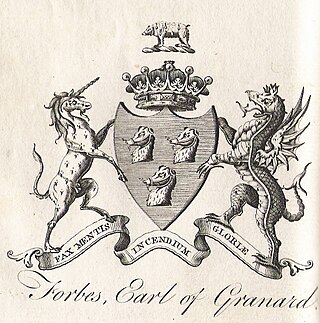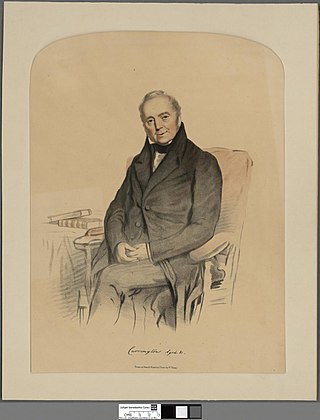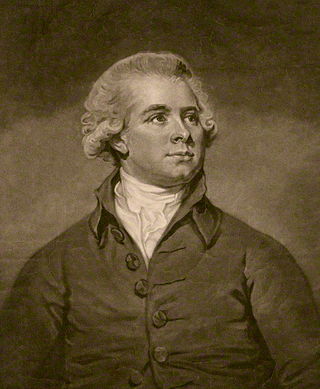
Marquess of Bristol is a title in the Peerage of the United Kingdom held by the Hervey family since 1826. The Marquess's subsidiary titles are Earl of Bristol, Earl Jermyn, of Horningsheath in the County of Suffolk (1826), and Baron Hervey, of Ickworth in the County of Suffolk (1703). The Hervey barony is in the Peerage of England, the earldom of Bristol in the Peerage of Great Britain and the Jermyn earldom in the Peerage of the United Kingdom. Earl Jermyn is used as courtesy title by the Marquess's eldest son and heir. The Marquess of Bristol also holds the office of Hereditary High Steward of the Liberty of St Edmund. The present holder of these titles is Frederick Hervey, the 8th Marquess and 12th Earl of Bristol.

Earl of Huntingdon is a title which has been created several times in the Peerage of England. The medieval title was associated with the ruling house of Scotland.

Marquess of Lansdowne is a title in the Peerage of Great Britain created in 1784, and held by the head of the Petty-Fitzmaurice family. The first Marquess served as Prime Minister of Great Britain.

Marquess of Linlithgow, in the County of Linlithgow or West Lothian, is a title in the Peerage of the United Kingdom. It was created on 23 October 1902 for John Hope, 7th Earl of Hopetoun. The current holder of the title is Adrian Hope.

Earl of Lindsay is a title in the Peerage of Scotland. It was created in 1633 for John Lindsay, 10th Lord Lindsay, who later inherited the ancient Earldom of Crawford. The two earldoms remained united until the death of the 22nd Earl of Crawford, also sixth Earl of Lindsay, in 1808. Then the earldom of Lindsay passed to David Lindsay, while the earldom of Crawford became dormant because no-one could prove a claim to the title until 1848. Both David, 7th Earl of Lindsay, and his successor Patrick, 8th Earl of Lindsay, died without sons, and the disputed claim over the earldom was resolved by the House of Lords in 1878 in favour of Sir John Trotter Bethune, 2nd Baronet.

Baron Burgh is a title that has been created twice in the Peerage of England.

Baron Hastings is a title that has been created three times. The first creation was in the Peerage of England in 1290, and is extant. The second creation was in the Peerage of England in 1299, and became extinct on the death of the first holder in c. 1314. The third creation was in the Peerage of England in 1461, and has been in abeyance since 1960.

Baron FitzWalter is an ancient title in the Peerage of England. It was created on 24 June 1295 for Robert FitzWalter. The title was created by writ, which means that it can descend through both male and female lines.

Earl of Granard is a title in the Peerage of Ireland. It was created in 1684 for Arthur Forbes, 1st Viscount Granard. He was a lieutenant-general in the army and served as Marshal of the Army in Ireland after the Restoration and was later Lord Justice of Ireland. He had already succeeded his father as second Baronet of Castle Forbes and been created Baron Clanehugh and Viscount Granard in 1675, also in the Peerage of Ireland. The baronetcy, of Castle Forbes in county Longford, was created in the Baronetage of Nova Scotia on 29 September 1628 for his father, Arthur Forbes.

Earl of Harrowby, in the County of Lincoln, is a title in the Peerage of the United Kingdom. It was created in 1809 for the prominent politician and former Foreign Secretary, Dudley Ryder, 2nd Baron Harrowby. He was made Viscount Sandon, of Sandon in the County of Stafford, at the same time, which title is used as a courtesy title by the heir apparent to the earldom. His son, the second Earl, held office under Lord Palmerston as Chancellor of the Duchy of Lancaster and Lord Privy Seal. He was succeeded by his eldest son, the third Earl. He was a Conservative politician and notably served as President of the Board of Trade from 1878 to 1880.

Viscount Gormanston is a title in the Peerage of Ireland created in 1478 and held by the head of the Preston family, which hailed from Lancashire. It is the oldest vicomital title in the British Isles; the holder is Premier Viscount of Ireland.

Baron Carrington is a title that has been created three times, once in the Peerage of England, once in the Peerage of Ireland and once in the Peerage of Great Britain.
Baron Kensington is a title that has been created three times, in the Peerages of England, Ireland and the United Kingdom.

Baron Henniker, of Stratford-upon-Slaney in the County of Wicklow, is a title in the Peerage of Ireland. It was created in 1800 for Sir John Henniker, 2nd Baronet, who had previously represented Sudbury and Dover in the House of Commons. His son, the second Baron, also sat as a Member of Parliament. In 1792 he assumed by Royal licence the additional surname of Major. He was childless and was succeeded by his nephew, the third Baron. He assumed the additional surname of Major by Royal licence in 1822. His son, the fourth Baron, represented Suffolk East in Parliament. In 1866 he was created Baron Hartismere, of Hartismere in the County of Suffolk, in the Peerage of the United Kingdom. This title gave him and his descendants an automatic seat in the House of Lords. He was succeeded by his son, the fifth Baron. He also sat as Member of Parliament for Suffolk East and later held minor office in the Conservative administrations of Benjamin Disraeli and Lord Salisbury. His grandson, the eighth Baron, was a prominent diplomat and notably served as British Ambassador to Jordan and to Denmark. As of 2014 the titles are held by the latter's son, the ninth Baron, who succeeded in 2004.

Baron Henley is a title that has been created twice: first in the Peerage of Great Britain and then in the Peerage of Ireland. The first creation came in 1760 in favour of Sir Robert Henley, Lord High Chancellor of Great Britain, when he was created Lord Henley, Baron of Grainge, in the County of Southampton. In 1764 he was further honoured when he was made Earl of Northington. On the death of his son, the second Earl, both titles became extinct. Lady Elizabeth Henley, youngest daughter of the first Earl and co-heiress of the second Earl, married the diplomat Morton Eden. In 1799, the Henley title was revived when Eden was created Baron Henley, of Chardstock in the County of Dorset, in the Peerage of Ireland. Their son, the second Baron, assumed the surname of Henley in lieu of Eden and notably published a biography of his maternal grandfather. His son, the third Baron, sat as Liberal Member of Parliament for Northampton. In 1885 the Northington title was also revived when he was created Baron Northington, of Watford in the County of Northampton, in the Peerage of the United Kingdom. This title gave the Barons an automatic seat in the House of Lords. The fourth baron Frederick Henley was an educated man who served as JP in Northamptonshire and married Augusta, daughter of Herbert Langham 12th baronet.

Baron Hindlip, of Hindlip in the County of Worcester and of Alsop-en-le-Dale in the County of Derby, is a title in the Peerage of the United Kingdom. It was created in 1886 for the businessman and Conservative politician Sir Henry Allsopp, 1st Baronet. He was head of the brewing firm of Samuel Allsopp & Sons of Burton upon Trent, and he also represented East Worcestershire in Parliament.

Baron Leigh has been created twice as a hereditary title, once in the Peerage of England and once in the Peerage of the United Kingdom. The writer Jane Austin is associated with this dynasty.
William George Hylton Jolliffe, 1st Baron Hylton, known as Sir William Jolliffe, Bt, between 1821 and 1866, was a British soldier and Conservative politician. He was a member of the Earl of Derby's first two administrations as Under-Secretary of State for the Home Department in 1852 and as Parliamentary Secretary to the Treasury between 1858 and 1859.
Hylton George Hylton Jolliffe, 3rd Baron Hylton was a British peer and Conservative politician.
William Jolliffe was a British politician who sat in the House of Commons from 1768 to 1802.












